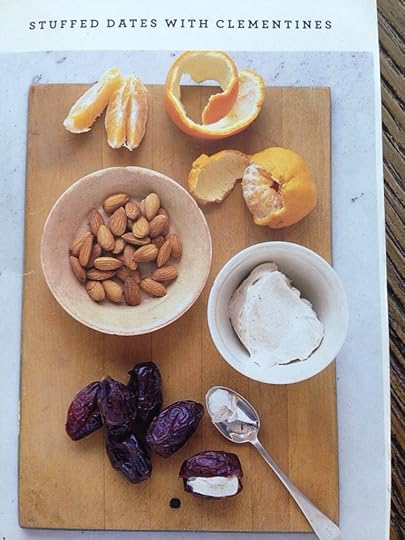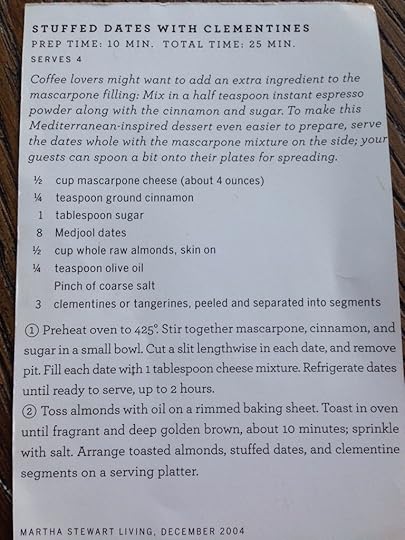Jonalyn Fincher's Blog, page 12
December 6, 2013
Talking Taboo for Christmas
Every now and again I meet a woman whose vulnerability is both intentional and well-tended. Erin S. Lane is such a woman.
As co-editor of Talking Taboo: American Christian Women Get Frank About Faith I asked her to talk about her newly published book and join me for an Emerald City.
Talking Taboo pulled me in immediately. In Chapter 1, Amy Frykholm (my first Emerald City guest!) essay writes about watching a female lecturer. This academician spoke deftly while revealing just enough cleavage (intentionally) to forbid the male dominated room from objectifying her as either an asexual academician or a piece of meat. Frykholm is the first of 40 women under age 40 to join their voices in this button-pushing about being female.

As Erin has explained this week at her blog “Holy Hellions:
In Talking Taboo, there are many essays that address what happens at the boundaries of our body – in the form of breast milk and menstrual blood, in the act of masturbation and sex . . . essays about what happens at the borders of our social body – in the debate over immigration reform and in the silence on domestic violence victims in prison.
Taboo is not just something that is considered off-limits. It’s something so powerful that it must be contained.
In this Emerald City, watch for Erin’s gift for clarity in her thinking, look for her capacity for intentional vulnerability. Some of my highlights:
Minute 12:53 on the “I Speak for Myself” dialog that begins with wonder about what’s going on in you. 15:36 why be child-free. 17:30 how to talk to women who don’t have children, by choice. Don’t miss 19:46 where I practice some vulnerability.
22:44 the “ministry of availability”. 27:27 what nuclear families can learn from broken families. 31:38 the problem with women thinking of themselves as “vessels.” 37 we talk about cross- sex friendship. By 44:33 Erin’s talking about “holy danger.”
My favorite line from our interview: “God needs you to be you.”
Erin will interact in the comments. Best comment or question (voted on by you) gets a free copy of Talking Taboo.
Here’s where Erin works: The Center for Courage and Renewal. And the homeless ministry, Family Promise, where Erin and her husband volunteer to take the night shift with the homeless. Finally, a link to Amelia Bedelia, the inspiration for Erin’s dog’s name.
Follow Erin @holyhellions
December 4, 2013
Hotter Than You
I’ve sat in rooms when a sexually strong woman opens the door and walks in. She changes the pace of my pulse, because I see her power. And it’s hard, for me, to not feel threatened.
Actually, I used to feel really threatened.
Now, I’m more curious. For over seven years, I’ve been studying what brings out female aggression (Tripping the Prom Queen is a great place to start). I like asking myself,
What turns my eyes sour? What makes my heart drop? What pushes me to compete? And what can move me from competitor to team mate?
I met a woman last week who has amazing curly hair, longer than mine, luscious curls. And her style is fantastic, touching her clothes, her house, her holiday activities. But it was her hair that gave me pause.
Thirty years ago, anthropologists couldn’t find enough scientific data to prove the female competitive component. We just had our intuitions, movies like Mean Girls, myths like Cinderella and her stepsisters, and Biblical stories, like Leah and Rachel.
Well, for all my skeptics out there, the research is out. Because more women, like Tracy Vaillancourt and Aanchal Sharma are becoming researchers we have this test with students at McMaster University where students thought they were simply answering questions. Vaillancourt and Sharma stages a woman interrupting the interview. Sometimes this woman wore jeans and a T-shirt. Other times she wore a short skirt and deep V-neck, tight top. What did she look like?
Evolutionary ten, which means “low waist-to-hip ratio, clear skin, large breasts.” I know, I know, you can roll your eyes, but until we get vocal about different types of beauty this is what we’re working with.

Can you guess what happened? In her jeans and T-shirt, the women being tested didn’t overly notice or remark on the interrupting female. But when she wore more revealing clothing?
Female aggression reared its head. The mean girls came out with comments, staring, looking her up and down (what I call the salty glance in Ruby Slippers), eye rolling, some showed anger. One asked the woman, “What the [expletive] is that?”
The worst part? the aggression mounted after the woman left the room. The students laughed at her, attacked her motives, one student suggested she was dressing to have sex with the prof.
Perhaps the most revealing part of these now abundant studies is what makes women feel competitive. It’s not our favorite whipping boy: celebrity culture. According to the studies, you and I may feel worse comparing ourselves to our peers than comparing ourselves to Kate Upton. Media influences us, but so do our girlfriends. We have an addiction to comparing.
And the competition soars if there’s a hot guy in the room (Read the NYTimes article “A Cold War Fought by Women“). You’re sitting in Starbucks and a hott woman walks in. You notice how you compare. But, when an attractive guys walks in, what happens? Whatever you’re feeling multiplies, right? Disappear or strut? The reaction depends on your own story.
Just this last weekend, I was skate skiing with a friend. She’s a better skier so she took the longer, harder trail and I stuck to the smaller circle. I felt empowered and strong and so darn proud of myself (I haven’t skate skied since my son was born three years ago) that when we reunited at the car I wanted to show her what I’d learned.
“Check this out!” I said starting to show her my new technique, “I figured out how to get up a hill faster.” I wasn’t concentrating properly (or was it too much?) and fell flat on my face.
Her willing laughter combined with mine, until . . . I spied a guy chuckling in his car in the parking lot. My embarrassment mounted.
I know men face this same feeling, you just have to watch Chevy Chase in Christmas Vacation with Merry at the lingerie counter to understand.
So why talk about this?
We must notice what we’re doing to change. Most of us, including myself, are quicker to judge a woman by her body and clothes before she’s opened her mouth. I’m disproportionately comforted when married friends have a tummy that matches mine. It’s like I relax a little more “We’re all in this together and you’re not going to Maria Kang me.” But, when I feel my pulse quicken and my competitor glance sweep another female, I know there’s work to be done.
Four ways to move out of competing for a mate and into loving as a friend.
Here’s to being more human this December!
I believe confession (a tried and true Christian practice) is one of the main ways we begin to approach an unhealthy, self-defeating pattern (or what the Bible calls “sin”) in our lives. I’ve written about confessing (one of my top five most popular posts: Our List of Intolerable Women), about our grown-up ways of being mean (Grown-Up Twist), and the Recipe for Frenemy Cake. These all explain why we must confess our competitor stance. I choose those I trust (in my case it’s my husband, in yours it could be a friend, a brother, God). I tend to think a male can be helpful in this instance (and a female for men) since much of female competition is about the Bridget Jones’ complaint of getting a good guy. If confession is hard for you, take a lesson from some of the experts in truth-telling. In the newly released book, Talking Taboo: American Christian Women Get Frank About Faith , forty women share honestly about the harder to admit things in their lives. I’ll be interviewing Talking Taboo editor, Erin S. Lane, this Friday for Emerald City. Stay tuned.
I make a mental list of what I like, what I appreciate, what I really adore in this “competitor”. And I try to find out how I can tell them so, either personally or publicly (twitter, facebook).
If I know this person, I’ll ask them for tips, which puts me in the place of a learner. It means I realize their strength is part of a gift to me, if I can just learn to ask.
I will wonder at why their beauty, or smarts, or success bothers me so much. And I will consider what feels like shame or disconnection in me that makes me feel unworthy next to them. Do I honestly think I need what they have to have a lovely life? Why is that?

I will imagine this person as a child to help remind myself that they have pushed out of their own struggles, too. My video explaining.
Give these gifts to your girlfriends this Christmas.
I promise there will be more peace and love.
November 27, 2013
Peace Before the Turkey (and my recipes)
When are the holidays as perfect as you want? When does the turkey taste as moist, and the kids play as nicely, and the guests go home as rested as you envisioned? When do the holidays bring you peace?
I want peace in my busy, rushy heart before the holidays even begin.
Here’s how I do it.
Noticing
I meet her often at the grocery store. She stacks the produce. Today, she helped me find Medjool dates for the gluten free dessert I’ve been hoping to make this Thanksgiving.
My son was blessedly absorbed in cleaning his new sunglasses so I had time to tell her about the recipe.
“Marscapone and cinnamon stuffed into the dates, clementines and almonds on the side,” I say, my eyes bright.
“My friend had a grandmother, from Eastern Europe, who made cookies with dates stuffed inside a ball of cream cheese dough.” She said.
“So when you bite in you taste the date?” I ask. She nods. It’s when she begins to tell me another recipe that I notice my impatience rise.
I try to ignore this anxiety: How many recipes is she going to share? Will Finn stay quiet? Do I have time to listen? Sue pauses and I respond, right on cue, “Why don’t we cook like that in America?”
“Because we’re always rushing,” She glances to the harried shoppers around the produce section. Today, is the last day to get good pickings in our small ski town in the Rockies.
Time to Make Love
Last night, my husband and I compared notes on how tired we felt, not the good tired, but the fatigue that keeps you from noticing each other’s eyes. When I don’t see the blue because I’m distracted by his red rims, we are too tired.
“Why are we like this?” he asked. We’re often taking inventory of why we feel the way we do and if there is anything we can change.
“Maybe I’m sick,” I suggest. Dale shakes his head,
“We’re still recovering from our two week fundraising trip, we’re still getting back on our feet.”
When we don’t have time to make love, we’re too busy.
That’s my husband’s motto.
It works outside the bedroom, too. Peace, or the Biblical shalom, means a rightness to the world, where justice and mercy smile into each other’s eyes. Peace yields the capacity for recreation, for rest, for pure fun.
Yesterday, I observed a young woman and an older, bearded man playing cards at the coffee shop. I stopped to compliment them.
“No one plays cards like this anymore,” I said, thinking primarily of myself who never has time for cards.
Tomorrow, my friend has requested that when we bring over turkey and stuffing we also bring games. She wants to play after the feast.
I’ve been belly-aching about the idea for weeks. But, the fun of playing “Uno” will bring a lot more peace than checking my email. I’ll actually see my friends in another light. Making time to play, I’ll notice there are more strategies than winning.
Let Peace Begin With Me
Today, I saw pixie dust on the air. It sparkled and caught my eye when I was supposed to be turning left. I stared at the champagne powder of Steamboat Springs danced in the sun. I felt full of that elusive happiness in my warm car.
But, as I turned left into town I wondered “How long will this feeling last?” Sure enough. It ended at our first top, to pick up 13 drinks from Starbucks for Teacher Appreciation Week when the barrista froze me out the pixie dust evaporated.
She stood, pen in hand, criticizing my slowness with a cold stare. I quickly read the first name, drink and then the size. She sighed loudly.
“Would it help if I said the drink size first?” I asked, like a rookie. She curtly nodded, pen poised like a rapier. I rattled off the next drinks. My son tried to share about his new sunglasses. She easily ignored him.
I watched her talk and laugh with her barrista buddy. I watched two more men come in and saw warm smile for them.
I began collecting my drinks which were making a pile on the “exit counter”.
“Are these mine?” I asked.
“I don’t know, what did you order?” the barrista retorted. I didn’t make a peep (which I’m sure got a standing ovation in heaven). Instead, I started looking at the writing. I asked for some drink carriers.
The barrista pointed to them stacked on the counter, “And, I put a few drink stoppers there for you.” Was this a hint of kindness? Her voice had softened.
“Thank you,” I said trying to meet her eyes. I carried them to the car in four trips, thanked each barrista and finished with, “I hope you have a good day.” It was as sincere as I muster.
I didn’t complain to the manager, not because that would have been wrong–I didn’t deserve the way the barrista treated me, but I have had lots of practice standing up for myself. Today, I wanted to conquer my own disgust at her, so I held my peace, held it tight. For peace is never easily won, it’s fought for, as the stories of David, and Esther, and Jesus prove. I cheered this barrista in my mind, watching and praying to see my peace spread to her face.
I saw others curiously watching our interaction.
I held my peace and when I left I saw the barrista smile at me.
Three Steps for Peace
Notice when and why you’re rushing. What got you here?
Ask yourself if you have time to make love… or play cards? If not, cut something out.
Hold your peace firmly as you move in this world.
My Recipes

From “Mad Hungry: Feeding Men and Boys” by Lucinda Scala Quinn
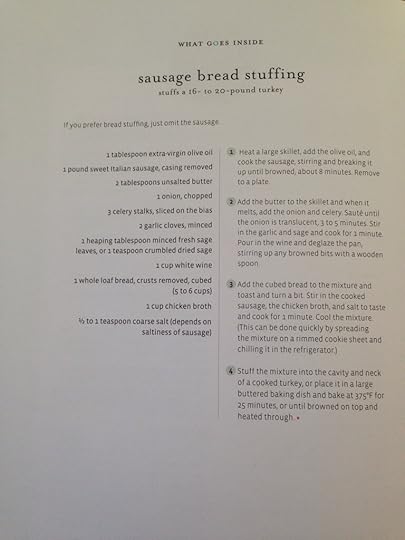
From “Mad Hungry: Feeding Men and Boys” by Lucinda Scala Quinn

From “Everyday Italian” by Giada de Laurentiis
November 22, 2013
When the Holidays Bring Grief
Sometimes the holidays make us more sad than happy. This is a video for those moments with five ways I practice grief.
Poem “Early February” can be found in Marilyn Chandler McEntyre’s The Light at the Edge.
November 20, 2013
What to Wear for the Holidays
“Style is a way to say who you are without having to speak”
Who hasn’t stood in front of their closet feeling at a loss for something lovely to wear? And with Thanksgiving around the corner and the round of holiday parties, Christmas, New Year’s, just when do you intend to find something to wear?
Isn’t it simply another chore, another vain chore at that?
I believe what we wear matters, our clothes offer a shorthand teaching people how to treat us. Our clothes identify our tribe, who we associate with, what we want to do, what we care about. Finally, in light of the beauty of God, our clothes are a chance to communicate something about God. From the monk’s habit to Katherine Middleton’s post-maternity dresses, our clothes tell a story. Even if it’s a story about how we’d rather be invisible.
Clothes tell the story of our lives. There is a gossamer blouse I wear with a cream camisole, reserved for Passover night. I own a black knit dress, with tiny embroidery detail on the shoulders and hem, I’ve only worn it for book clubs and poetry nights. There is eye shadow that I set apart for date nights with Dale. There are clothes that I only wear with him. There are clothes that I only wear on long snowshoes or long backpacking treks. There are clothes that I reserve for weddings, for funerals, for depressing gray days when I cannot write because of a headache. There are clothes for journeys and clothes for work.
It is God who made the first clothes in Eden, it is God who redeemed clothes to signify beauty and glory when his people stood before him. In the tabernacle, the God of Israel instructed Moses to fashion garments for glory and for beauty for his brother Aaron, the High Priest (Exodus 28:2). Beauty can translate to holiness when we’re in the presence of God.
And on earth, we are always in the presence of God.
I’m not saying you have to be a fashionista. Fashion queens don’t necessarily know more about beauty than you do. But, how often have you heard a sermon about how what you wear is a way to worship God? As far as I’ve found, many of the people who care about fashion also care about beauty.
Some may call this vain, as in “beauty is vain” from Proverbs 31:30. But, beauty is also the attribute of God that David longed for from his throne room. (Ps 27:4). Not all fashion is beauty, but let’s not throw the baby out with the bathwater and think the way we dress no longer matters. If God made us, and then brought us our first clothes (furs at that), if God’s people always connected clothing with part of their worship or mourning, shouldn’t thinking about clothes be part of our lives, too?
Today, I interviewed Erin S. Lane for an Emerald City on her recently released book Talking Taboo (Look for that interview December 6). Erin showed up on my screen with her blond hair neatly styled, a boatneck emerald sweater perfectly framing her swan neck, and ripe tangerine lipstick. I notice these things.
I felt like she had honored me with the simple act of dressing with loveliness. Her clothes, her style, her attention were all a gift inviting me in. Her style communicated beauty and glory. And it framed our conversation.

French model of the 60′s, Brigitte Bardot, who made voluminous hair iconic.
Last month, I took a happy dive into Paris Street Style: A Guide to Effortless Chic. I already knew I liked the way French women dressed. The French believe in less make-up and more individuality, the French choose classic simplicity more than trends, the French care about basic, quality pieces. The French have a history of finding messy, fabulous hair styles and celebrating them. Need I go on?
And since reading this manual, I’m sincerely trying to find a bit of myself in every outfit, every day. I’m finding lots of my clothes are a reflection of a great deal, or a sudden fad and not, truly a reflection of who I am.
So, it comes to this, what do you value in clothing?
What can you wear that reflects you these holidays?
What do you love wearing that looks beautiful, glorious, even set apart for the occasions we are about to honor, the greatest of which is the birth of the most human of all men?
Some tips to make it easier (and more fun):
Let an “era” inspire you. For instance, I bought a Boden Peter Pan collared shirt as a staple item over a year ago. It layers really nicely with sweaters and vests. I added two pieces from a local consignment shop: Banana Republic vest and skirt. Then, the striped grey and black tights keep that stripe-y thing going. I’m not sure it’s fashionista, but I’m proud of it. I took a cue from the women on Mad Men to put together these stripes and neutrals and added a long silver chain (with key) to complete the look. It felt really fun. Now, let’s say I wanted to take this same outfit to a party. What could I add? Large, sparkly, dangly earrings? a French twist in my hair with jeweled pins? a black, velvet jacket? stillettos? or what about a shorter black skirt and fishnet tights? Now, we’re talking!

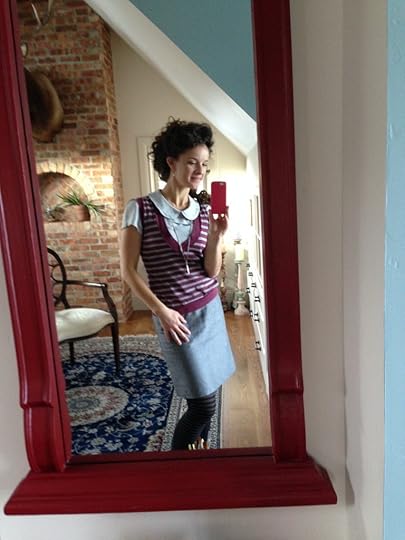
Before you go to bed, choose pieces you think will work (hang them up or drape them on a chair next to each other), this will save time of trying on and discarding a heap on your bed in the morning.
Take advantage of the inundation of mags this season. Look at clothing catalogues to copy a look instead of plunking down more money. Tear out the pages you love, punch 3 holes and put them into a 3-ring binder. When you’re feeling uninspired, flip through.
Don’t ever buy something at a second hand or consignment store that isn’t 100% right. Chances are you’re feeling adrenalin simply because of the price and the chance to get something new. Once it’s home the stuff you overlook will swell to bother you. You won’t wear it.
When choosing an outfit, try a surprising bright color in one spot: all greys and a bright blue scarf, or all black and white and a violet pair of shoes.
Accessories: this is what separates the girls from the women. Choose these well, spend extra money and time choosing wisely. For instance, the perfect handbag. I found a treasure six years ago, but the quality of leather is such that it looks even better now, even after sippy cups, granola bars and lotion spills. I’ve toted this bag across the seas and criss-crossed in planes with a newborn, toddler and now three-year old. I paid $120 for it, which felt astronomical at the time (I don’t do brand name handbags). But it was worth it. Everywhere I go I get compliments and it’s still intact. I’ve also spent money on cute, fun (at the time), trendy purses… but none of them has stood the test of size, durability, and beauty as this tote.
If you’re stuck in a style, try noticing the people around you who have a similar body type and dress in a way that is interesting, lovely, inspiring to you. Then, copy! I always felt inspired by my friend Emily, especially when we were pregnant at the same time. She pulled something off that looked lovely, even when she was eight months pregnant.
Finally, give yourself the freedom to practice. Style, fashion, beauty, does not (contrary to the gremlins) come naturally to any woman. No beautiful outfit springs together. There is not fairy godmother wand to make a holiday dress, scarf, hose, shoes, hair, earrings all work, not without effort. The woman worked for that look and she had plenty of mishaps along the way. It was planned, rehearsed, cultivated. And you can do it, too.
For more, check out Paris Street Style. My library had a copy.
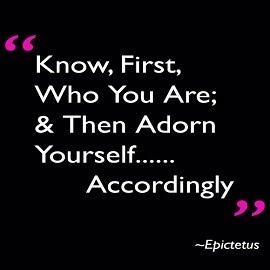
November 15, 2013
Is it Okay to Love Myself?
I heard it from the female pillars of the church. God first, husband second, self third. Or, I’d hear the Christian acronym J.O.Y. which spelled out Jesus first, Others second, You last.
It doesn’t take too much intelligence to realize that your needs aren’t really top drawer. You might even think: Can I only take care of myself after everyone else gets fed and washed and put to bed? Is that what discipleship means? And if you read the Bible, you might take verses like “regard one another as more important than yourselves” forgetting that Philippians 2:3 in context actually does talk about self care.
In the comments of “Women Who Breastfeed in Church“, both Erin and Katie (two faithful readers) asked me to explain more about “self care being integral to discipleship with Jesus.” I thought the question deserved some expert advice, so I brought in one of my besties: Dr. Sally Falwell.
I’ve written with Dr. Sal, clinical psychologist, or years. We co-own a blog, The Art of Friendship, where we write on female friendship. But this week, Sally joined me for our first Emerald City.
Together we tackle the common tension between selfishness and self-care. You’ll find these versus coming up in our discussion.
“Do nothing from selfishness or empty conceit, but with humility of mind regard one another as more important than yourselves; do not merely look out for your own personal interests, but also for the interests of others.” (Phil 2:3-4)
“Treat others the same way you want them to treat you.” (Luke 6:31 and Matthew 7:12).
N.B. The video stutters for the last 10 minutes, but the audio is stellar all the way through.
Follow Sally @DrSallyFalwell. Learn about her work in mental health at Legacy.
November 13, 2013
Why I Am a Christian Humanist
Scooby Doo taught us that the real monsters are human.
Think of all the evil on earth, a good chunk of it can be credited to humans. Some of the most horrible things that have happened to you and me were invented by a human mind.

I recently finished My Story by Elizabeth Smart, a day-by-day account of the monotony of her life during the nine months of her kidnapping. Her kidnappers used false religion to justify their emotional, physical and sexual abuse. Smart was not taken in, she says, but her capacity to fight back was destroyed. Perhaps, we liked Smart’s story so passionately because the villains were so obvious. We knew when justice had been served.
More often, human have little idea of how much we are going to hurt each other. We participate in group evil in places that seem full of God’s blessing. How often the (false) church has been the handmaiden to manipulation, consumerism, extortion, false guilt, coerced service. Blaise Pascal wrote, “Men never do evil so completely and cheerfully as when they do it from religious conviction.”
My husband regularly writes and vlogs about the spiritual abuse of well-meaning, modern day Pharisees at FreeAtLast.me. One of my favorite examples of what he suffered, “Why did you stay at Pensacola Christian College?”
I see in my husband, Dale Fincher, a rare blend of tenderness with truth. Like a modern day prophet, Dale refuses to be harsh or vengeful as he critiques the systems of thought that kept him from Jesus’ living water even while claiming to be the one true church. Others who attended his college chose another way. Some refuse to make a peep about anything negative (as if Jesus told his followers to always be positive–tell me, where is that written?). Others have chosen to leave the faith altogether. This first comment in Dale’s post “What is Spiritual Abuse?” is a perfect case in point “This is exactly what was done to me and 20 plus years later I still haven’t made it back to church….”
What kind of response can we give when humans (even in the church) behave like monsters? Does our Christian anthropology have more to say then, “Well, we’re all sinner, what do you expect?” Do we have some good news?
Coffee Shop Conversations in Beverly Hills
Last weekend, I attended a friend’s wedding in Beverly Hills. An Indian man and his girlfriend chose to sit by me. Coincidence? 
After a few minutes of conversation the man shared some of his reasons and summed up, ”That’s why I’m an atheist. I believe all religions should all just learn to get along.”
I told him I agreed with him. “I think we need better, more sustained civil discourse. But I’m a Christian humanist. And I’d imagine you’re a secular humanist, so this is one point we’ll agree.” He was nodding. I went on, “The main difference between you and me is you’re using spirituality to improve your positive energy, but I’ve fallen in love with God.”
He (and his girlfriend) knew precisely what I meant.
I’m not sure it was my best line, but I’m constantly trying to find new ways to talk about Jesus (more more see Coffee Shop Conversations).
People think they know Christians, and our Christ and our hypocritical, homo-phobic, judgmental, overly-political ways. And then they get a chance to meet one of us.
It’s not that Jesus is false or his people are failing as much as Jesus’ PR is failing.
And that needs to change.
Why I Am a Christian Humanist
That word “humanist” has easily been assigned to the atheist, but it doesn’t only belong to them. In fact, if you believe God created humans, then humanists could actually be God-fearers, too.
Christian humanism is neither secular or atheistic. Rather, it’s a way to talk about Jesus’ good news, without getting the instant dismissal and glazed eyes, a way to prolong our spiritual conversations and introduce others to our Savior.
Christian humanism couples the delight in this life with the assurance that God made us human on purpose. Human. Sexual. Sensual. Desire-Filled. Hungry. Thirsty. All on purpose.
Remember Jesus’ words, “Blessed are you who hunger and thirst for righteousness, for you shall be filled” (Matt 5:6). Jesus taught us to be more fully human, how to live as a human, how to die and rise as a human. He provided the example, but even more, he provides the power of God for salvation. And from what do we need to be saved?
From ourselves, from the monsters humans can become. Soulation is about helping people become more fully human, with the hungering and the thirsting for righteousness.

So, you might be wondering, just what is a Christian humanism? What ingredients make a Christian a humanist?
a person who is attached to orthodoxy while open to the world.
a person who believes in life before (and after) death.
a person who wants to assimilate scripture into culture, not reject or accommodate (either the Christian subculture or the world’s pop culture).
a person who is living with the paradox that life is tragic yet contains a persistent strain of hope.
a person who refuses to relinquish two vital ingredients of our intelligence: imagination and reason.
Dale introduced Christian humanism to me. I’m glad to say it has helped me hold onto my love for humans, my delight in the humanities, and my conviction that Jesus came to make me more fully myself.
What do you think of Christian Humanism? Does it ring true for you?
November 8, 2013
Emerald City: Atheist and Christian Discuss Sex
I’ve followed Emily Heist Moss‘ articles at Role Reboot for some time. But it wasn’t until I tweeted up how I disagreed with her article “What Sex Counts as ‘Real’ Sex?” that she and I got a chance to interact. Emily watched my vlog here at RubySlippers where I give her my counter-argument. And then, Emily kindly agreed to a friendly debate. Live. Recorded.
What follows is one of my favorite Emerald Cities thus far: an atheist from Chicago and a Christian from Colorado debate and even agree about sex.
Liked Ms. Moss? Check out her blog. Watch for her at Role Reboot. Follow her on twitter @rosiesaysblog
November 6, 2013
Can Men and Women be Close?
I have good friends, both men and women. But it wasn’t until my 30′s that I started to notice that friendship requires some mad skills that most of my teen and early adult life did not teach me.
Much of my skill set came from the relationships I have with two very different people: my husband, Dale and my girlfriend, Sally. That picture above is from Dale and my engagement days in Laguna Beach. Sally is a friend, I met in Steamboat over five years ago. Sally has since moved to Virginia and now to Texas, but I want to make the rather bold claim that we are even closer now, thousands of miles apart.
From both of them I’ve learned the ingredients of friendship. From my last few years of trial and error, I know a bit more about how to share friendship across the sexes.
Close
So what makes a friendship close? It’s not simply or necessarily geographical proximity. Not with texting, phone calls, Skype, Voxer, and the hopes of visits to plan for and anticipate. I know more about Sally’s daily and interior (read soul) life than most of my friends in Steamboat, than most of my family members (except for Dale).
Close, to me, means you have potential to be your kitchen table self.  It means you’ve cultivated an interest in what makes your friend tick, what they’re worried about this week, what they’re wondering and planning and grieving. It means you share each other’s burdens and you have a measure of mutuality. You’re not always the listener, you’re not always the sharer. And, perhaps the biggest litmus test for true closeness is that you are free to share when you’re bothered, hurt, or struggling WITH your friendship.
It means you’ve cultivated an interest in what makes your friend tick, what they’re worried about this week, what they’re wondering and planning and grieving. It means you share each other’s burdens and you have a measure of mutuality. You’re not always the listener, you’re not always the sharer. And, perhaps the biggest litmus test for true closeness is that you are free to share when you’re bothered, hurt, or struggling WITH your friendship.
As my friend and marriage therapist, Robin Moore, explained once (during Soulation’s GREEN Couples Gathering) there are two kinds of communication: process and content. In process communication (or meta-communication) you’re talking about how you will talk, for instance, you might text, “Got some important news, but want to call you. Can we talk instead of text?” Content is what you talk about, for instance, “My mom just told me the Grand Canyon trip will happen, do you want to go?” Content is what we often do easily, just share our days or our thoughts. But process communication takes a measure of intentionality, maturity, and self-soothing. Most of us don’t want to get “so deep” to talk about HOW we need to communicate. It sometimes feels forced and it always feels difficult.
On My Mind
For a long time, I took my family’s phrase “Out of sight, out of mind” as a mantra for my own life. If a friend moved away I assumed that means our relationship wouldn’t be as close. But when I turned 21, I met Dale Fincher who introduced me to a new way of doing relationships.
We had been dating less than a week when Dale left for a cruise in the Mediterranean, he had a grandpa in his life who gifted him with these amazing opportunities. On a sailboat, without access to easy internet, Dale would type pages to me every evening. He was so dedicated to keep me updated on his life in Italy and Greece and Turkey that his grandpa commented on his absorption with “this young woman.” I had my pulse on the moment: this was love. On that trip, in Istanbul, Dale purchased the diamond that sits on my ring finger today. He sent me pictures as attachments of him reading Jane Eyre on the Mediterranean coast, it was the book I told him was my favorite.
Many could see Dale’s attention to me as typical pre-nuptial wooing, a dedication and intensity that soon dies away into normal marital life. However, Dale (and now I) realize this is a mark of all good friendship. My friends are “on my mind” when I’m doing something that would interest them. So, I send pictures that I think they’d enjoy. I share funny stories or frustrating moments when I know they want to have me on their minds, even when we’re apart. If a friend has shared an idea or question with me, I want to take time to wrestle with their ideas on my own. Next time we’re together, I can show them what I’ve discovered.
 I have a friend, let’s call him Jay, who is traveling in Europe right now. He sends me (and Dale–who is also his friend) pictures of the food and art treasures he’s finding via Voxer (best app for overseas communication). He sends recorded audio of the mass he heard, the music of the choir practicing scales. I can share with Jay I appreciate him, that he is on my mind, that I love and value him, even though he is a man.
I have a friend, let’s call him Jay, who is traveling in Europe right now. He sends me (and Dale–who is also his friend) pictures of the food and art treasures he’s finding via Voxer (best app for overseas communication). He sends recorded audio of the mass he heard, the music of the choir practicing scales. I can share with Jay I appreciate him, that he is on my mind, that I love and value him, even though he is a man.
Love’s Limits
As the German Catholic philosopher Joseph Pieper teaches, “Love says it is good that you exist.” And as a C.S. Lewis scholar and friend of mine, Jason Lepojärvi, has further explained to me,
“Love says that it is good that you exist and in so far as I am able I will contribute to your happiness, your existence, your flourishing”. The word “able” is a loaded one, as it includes time restrictions, physical restrictions, and appropriateness (for instance, as you are not my wife I cannot love you in all ways).”
If men and women are to be close they must keep an eye to the way love can legitimately flourish between them. I have some male friends who are not comfortable with meta-communication. That puts up a limit in how I contribute to flourishing in their life. I can only share so much before we hit that wall of discomfort.
I have a male friend who I rarely, if ever, compliment his physical appearance because he grows self-conscious and miserable in the aftermath. For now, those compliments do not contribute to his happiness, so I leave them on the shelf. I have male friends who compliment me with endearing nicknames when they write or talk with me. I wouldn’t share them here, not because I’m ashamed, but because they’re special to me and part of my private life. I share them with my husband or close friends, but each of these nicknames points out some beautiful thing about me they love.

Don Draper and Peggy Olson of Mad Men, whose platonic relationship is as unusual as it is a treat to watch.
A new male friend, Josh Brahm, has recently asked me a very practical question in the comments of Harry and Sally are Wrong: Friendships Between Men and Women. I’d like to finish by answering it, “How do you both give and receive compliments about the physical appearance of your cross-sex friends without being AWKWARD?”
A few tips I’ve picked up
Don’t drop your eyes in embarrassment when you’re complimenting. That tends to communicate discomfort (or ulterior motives). If you cannot make eye contact and say, “You look great with a shaved head.” and smile and comfortably move the conversation to another topic, you’re not ready. I recommend you start practicing complimenting your same-sex friends. I gave a lot of women a lot of compliments on their physical appearance before I started telling men they looked amazing.
Consider the place your cross-sex friends have expressed or seem to feel ashamed of their appearance. My hair, for instance, is a place of shame for me in my past. So when a man compliments my hair, I feel seen and known and quite grateful. If you have developed a compliment history where you can say some general things, e.g. “That outfit looks great (or beautiful or very good on you)” then you can substantially love your cross-sex friends by complimenting the things they don’t see beauty in themselves.
A simple, “Thank you” with eye contact and a smile is all you need to receive a compliment. No need to gush or protest, just “Thank you.” But, here’s the hard part, don’t rush to move to another topic, really let yourself sit in the warmth and awkwardness of people noticing you, seeing you, loving you. This is a wonderful exercise to practice with your spouse. I love when Dale and I are so connected that after his compliment I can find and hold his eyes. Then, only a warm and sustained smile and maybe a hug is all the communication we need afterwards.
November 1, 2013
Lust in the Workplace
Rachel brings us our question today from the comments in the popular post “Lust: Alive and Well Among Women: Part 2“.
Below the video you’ll find three tips to defang lust.
Imagine this person as a child, and the non-sexual aspect of their life at that time. Interact with them with the awareness of their wounds and vulnerability.
Imagine this person with someone else and how you can encourage, praise, support and build that union.
When you feel tempted to lust after this person, pray for their peace, their growth, their soul. You can enjoy someone’s body and still pray for their good at the same time. You’d be surprised how that defangs lust’s appetite. It transforms lust into something more sustaining, the desire to love them better.
Jonalyn Fincher's Blog
- Jonalyn Fincher's profile
- 9 followers


